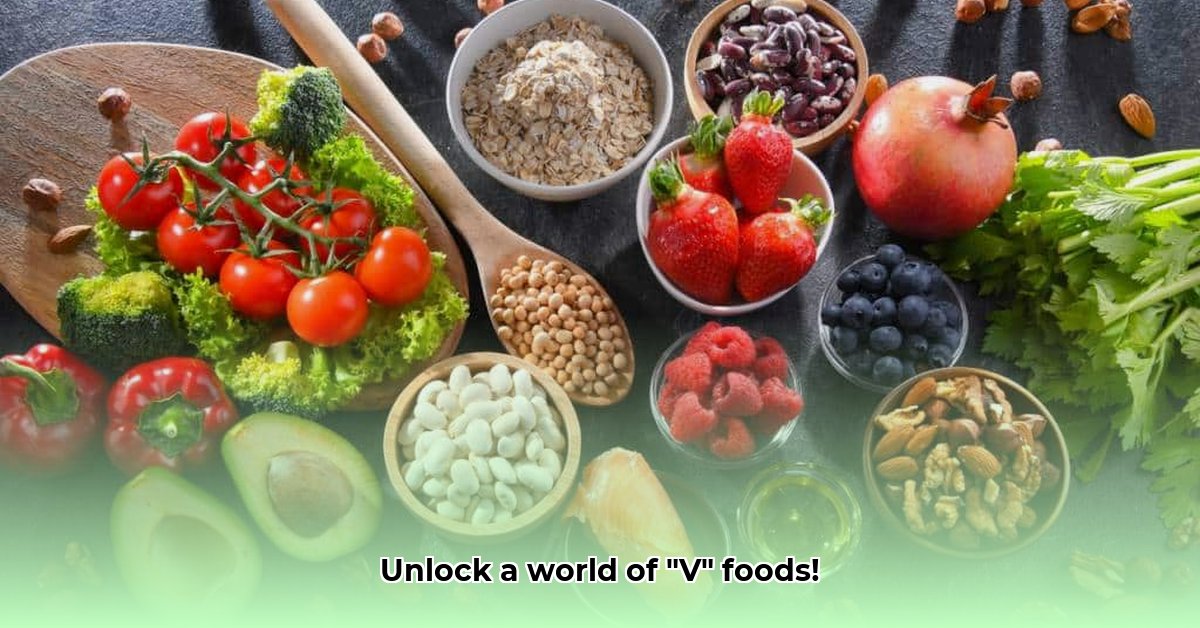Ever thought about how many delicious foods start with the letter “V”? It’s far more than you might imagine! From the familiar vanilla ice cream to dishes you’ve probably never even heard of, this culinary journey takes you across continents, exploring the amazing variety of foods that begin with “V.” For even more “V” food inspiration, check out this amazing resource: V-food recipes. Let’s embark on a flavorful quest, uncovering the diverse range of culinary delights that begin with this intriguing letter. This exploration will highlight not only familiar favorites but also introduce you to lesser-known culinary treasures, providing a rich, global perspective on “V” cuisine.
A World of Flavors: Exploring “V” Foods
Embark on a delicious adventure as we explore the amazing variety of foods starting with the letter “V” from around the globe! You might be surprised by how many tasty treats are out there. Let’s dive into this fascinating culinary world and discover the surprising diversity of “V” foods across global cuisines, highlighting their global distribution and cultural significance. This culinary exploration aims to showcase the breadth and depth of “V” foods, from staple ingredients to complex regional specialties.
Familiar Favorites: Everyday Eats and Global Mainstays
First, let’s talk about the V-foods you probably already know and love. Vanilla, that incredible aromatic spice, is a global superstar. Derived from orchids, its complex flavor profile elevates everything from creamy ice cream to decadent cakes. Vanilla’s sweet scent and flavor are practically everywhere. Its versatility stems from aromatic compound ‘vanillin’, lending a marshmallow-like essence. Vegetables, of course, form the backbone of countless cuisines, think of the humble potato, a staple in countless nations, prepared in myriad ways.
And speaking of versatile ingredients, don’t forget the many vegetables starting with “V”! Think vibrant purple vegetables like eggplant, the humble green bean, or the summer squash family. Zucchini and yellow squash are just a few examples. Each of these plays a crucial role in kitchens worldwide, demonstrating incredible adaptability across countless recipes. Have you ever noticed how many different preparations there are for even something as simple as a green bean? These versatile ingredients are essential building blocks. As a dietary cornerstone, vegetables provide essential vitamins, minerals, and fiber, contributing to overall health and well-being.
Region-Specific Culinary Treasures: A World Food Tour of Flavors
Now for the fun part – let’s travel the world and discover some unique dishes! Let’s embark on a culinary journey, exploring regional variations of dishes starting with “V” and Mastering Regional V Dishes Preparation Techniques Across Diverse Cultures. We’ll explore how similar ingredients transform based on local traditions. From the bustling streets of Mumbai to the elegant dining rooms of France, each dish tells a story of culture and culinary innovation.
South Asia: A Spice-Infused Adventure with Vibrant Flavors
India is home to vada pav, a legendary street food. Imagine a crispy, spiced potato fritter nestled inside a soft, fluffy bread roll. It’s a simple combination, yet unbelievably flavorful and immensely popular. The crisp exterior contrasts beautifully with the soft potato interior. Its widespread appeal perfectly showcases the rich and diverse culinary heritage of India. What’s your go-to way to enjoy this classic? Perhaps with some extra chutney? Its preparation involves precise techniques of battering, frying, and assembling, resulting in a savory street food classic. Commonly served with chutneys and enjoyed across India as a quick and satisfying snack, vada pav exemplifies the country’s vibrant street food culture.
Europe: A Culinary History Lesson with Heritage of Refined Flavors
Europe boasts its own delicious “V” foods. Let’s start with Vichyssoise, a smooth and creamy French potato and leek soup. Often served chilled, it’s a classic example of French culinary elegance. Its elegant simplicity belies its rich history and sophisticated flavor profile. Mastering its velvety texture requires careful blending and chilling. Its a classic example of how simple ingredients can create complex, delightful flavors, reflecting the nation’s culinary sophistication. Legend has it that the soup was created for King Louis XV, who feared being poisoned, leading to his soup being tasted by many and served cold.
Then, let’s journey east to Russia and discover Veal Orloff— a comforting casserole made with tender veal, earthy mushrooms, and a rich, creamy béchamel sauce. Each bite is a journey through history, a delicious testament to Russian cooking traditions. A classic of Russian cuisine, veal Orloff presents a creamy, indulgent veal dish, often incorporating mushrooms and Béchamel sauce. Each layer contributes to a symphony of flavors and textures. Created by French chef Urbain Dubois, who served Prince Orloff, the former Russian ambassador to France, veal Orloff epitomizes the fusion of French culinary techniques with Russian ingredients.
Beyond the Usual Suspects: Hidden Culinary Gems and exploring lesser-known Dishes
Beyond these well-known dishes, a whole world of “V” foods awaits discovery. Many other regions offer unique “V” dishes reflecting local ingredients and traditions. Latin America boasts a wealth of various types of beans—each with its unique flavor and cultural significance. Consider cheese-filled pastries, which appear in countless variations across many cultures. Vietname savory pancakes and vibrant salads from the Mediterranean is also a culinary options. From pierogies in Eastern Europe to empanadas in South America, these savory treats showcase the global exchange and adaptation of culinary ideas. The possibilities seem endless!
Let’s explore some specific examples of lesser-known “V” foods:
- Vatapá (Brazil): A traditional dish made with bread, shrimp, peanuts, and coconut milk, showcasing Afro-Brazilian culinary influences.
- Vori Vori (Paraguay): A thick, hearty soup made with cornmeal dumplings, chicken broth, and cheese, reflecting Paraguay’s rich culinary heritage.
- Veka (Czech Republic): A fluffy white bread roll, similar to a baguette but wider and softer, often enjoyed as a staple in Czech cuisine.
- Verhuny (Ukraine): Sweet, deep-fried dough pastries, also known as angel wings, dusted with powdered sugar, a popular treat in Ukrainian cuisine.
These dishes, and countless others, highlight the incredible diversity of “V” foods around the world.
Culinary Connections: Shared Techniques, Unique Flavors and Global Influences
Interestingly, many seemingly different dishes share common cooking techniques. Many “V” dishes, despite their distinct origins, share underlying preparation techniques. Think about dumplings or various cheese-filled pastries. Across the globe, cultures independently developed similar preparations, each with its own unique twist. Consider exploring Vietnamese vegetarian dishes utilizing varied vegetables or South American variations on vegetable stews. This fascinating culinary exchange demonstrates how food traditions evolve and adapt over time. It’s a testament to human ingenuity and the interconnectedness of our global community. What is the importance of culinary exchange for the diversity of global cuisine?
Dumplings, for example, appear in countless forms across various cultures:
- Vareniki (Ukraine): Savory dumplings filled with potatoes, cheese, or meat, boiled or fried, and served with sour cream.
- Vori Vori (Paraguay): The cornmeal dumplings in this soup share a conceptual similarity with dumplings found in other cultures, despite the vastly different flavors and ingredients.
These examples demonstrate how culinary techniques and ideas travel and transform across borders, creating a rich tapestry of global cuisine.
This journey through the world of “V” dishes showcases the extraordinary diversity of global cuisine. The community-verified recipes for delicious V dishes from around the world offer a window into different cultures, histories, and traditions. These variations highlight the fascinating adaptability and evolution of culinary traditions. They remind us that food is more than sustenance—it’s a connection to our heritage, our families, and our shared human experience.
- The letter “V” unlocks a surprisingly diverse range of culinary traditions and ingredients worldwide.
- Many “V” foods highlight regional culinary identities through unique ingredients and preparation.
- “V” dishes showcase culinary fusion and adaptation across cultures highlighting history, geography, and ingredient availability.
There’s always more to discover in the vast and wonderful world of food, so the next time you encounter a food beginning with “V,” take a moment to consider its origins and the story it tells. Further research is always welcome – perhaps you’ll discover your new favorite dish! From learning about cultural origins to experimenting at home, there’s no limit to the culinary adventures that await.
- Smart Meal Prep Recipes Gluten Free for Dietary Needs - November 29, 2025
- Gluten Free Meal Prep Ideas for Delicious, Hassle-Free Eating - November 28, 2025
- Gluten Free Meal Prep for Stress-Free and Healthy Eating - November 27, 2025










